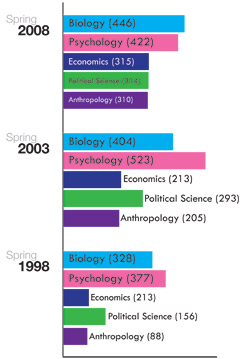Academics | National News | News
A major transformation during tough economy

Students’ majors across subjects within Arts & Sciences prove variable over the last decade. (Josh Goldman and Mary Yang | Student Life)
Students across the nation are seeking to major in fields that traditionally lead to secure employment, resulting in a drop in enrollment in the humanities and other liberal arts fields, The New York Times reported. At Washington University, students are embracing these majors, and the University is taking steps to ensure that they are marketable.
Patricia Katzfey, a career development specialist in the Career Center, said many different areas of the University are working together to ensure each student’s success.
“I think what is happening specifically here at Wash. U. is that a lot of departments are really taking the whole student into consideration, looking at how we play as a research institute and how we prepare the student for the real world,” Katzfey said.
The Career Center works to ensure each student develops certain core skills. These include communications skills, analytical skills, leadership skills and the ability to work in groups.
“Washington University is really trying to look at those core skills,” Katzfey said. “No matter what the student majors in, they are going to have core skills that will be sought after and will serve the student in whatever career aspirations may follow.”
But there are still certain majors that tend to lead to greater success in job searches.
“I think there definitely are some majors that employers have a preference toward, those that have a strong analytical background that definitely will help serve them in many, many corporate environments,” Katzfey said.
For students pursuing liberal arts degrees, the University offers the Praxis Program. This program integrates the liberal arts degrees with practical experience with the skills necessary to a successful job search.
“I think because the economy is the way it is, and the fact that we are all looking very seriously at how to continue our employment, how to continue our lifestyles and our economic tastes, we’re having to look into those practical aspects,” Katzfey said.
According to the Office of Student Records, there were 48 students in the Praxis program in spring 2003, compared with 78 in spring 2008.
Nationally, a number of universities have eliminated programs in less traditionally practical fields. For instance, the University of Louisiana cut its philosophy major earlier this year. At Washington University, such programs continue to be strong.
The classics major has demonstrated a significant rise in enrollment. There were five declared classics majors in spring 1998 and 37 in 2008. Philosophy has shown a similar trend, with 25 philosophy majors in spring 1998 and 48 in spring 2008. Overall, the humanities have consistently represented between 15 and 20 percent of Arts & Sciences majors from spring 1998 to spring 2008.
The most popular field of majors in the College of Arts & Sciences is social science, commanding 35 to 40 percent of majors. In particular, economics has seen a rise in majors, from the seventh most popular major in Arts & Sciences in spring 1998, with 75 majors, to the third most popular in spring 2008, with 315 majors.
It should be noted, however, that the total number of declared majors in Arts & Sciences at the University increased from 2,140 in spring 1998 to 3,818 10 years later in spring 2008.
The popularity of majors is responsive to changing trends in the workforce.
“You think business is always going to be important, but I think we’re going to see some shifts,” Katzfey said. “To which direction, I really couldn’t say for sure.”
Katzfey predicts the emergence of many “green jobs.” The environmental studies major has seen an increase in interest, from 53 declared in spring 1998 to 95 declared in spring 2008.
Additionally, she predicts that biomedical engineering (BME) will continue to be in high demand. Students at the University are responsive to this. Although there were only 40 BME majors in spring 1998, the department has since expanded to 235 majors 10 years later.
Although Katzfey believes engineering majors of all sorts will consistently be competitive in the job search, some departments are seeing a significant decline in enrollment. For instance, the electrical engineering major was one of the school’s most popular in spring 1992, with 201 majors. Currently, only 43 students are pursuing that degree.
Regardless of students’ majors, the Career Center is working with students and academic departments to prepare students for a successful job hunt.
“I think we’re doing all the right things to really prepare the student,” Katzfey said. “We want to be there to help them through all of the professional challenges [and] the emotional challenges that go with that, to help them with navigating that transition from this very nurturing academic environment to what the real world is like.”
Additionally, the Career Center is working with alums and prospective employers to determine the trends in hiring so that they can better prepare students.
“That’s also bringing a lot more practical, real-life experience and understanding to the student population,” Katzfey said.
Katzfey reminds students that it is ultimately their responsibility to seek the Career Center’s guidance, but the Career Center is then happy to give students all the tools they can to succeed.
“It starts with the student,” Katzfey said. “They have to take the lead, and we’re here to serve them.”
